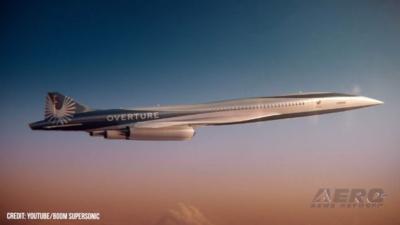Boom to Bust
Boom Technology, the American company about the much publicized business of bringing to market a supersonic civilian airliner, has lost its engine partner, Rolls-Royce. Notwithstanding inconveniences the likes of nonexistence, the aircraft—to which Boom has ascribed the jaunty moniker, Overture—has garnered 206 orders amounting to over $4-billion.

A 2020 engagement agreement between Boom and Rolls-Royce established, albeit informally, the latter’s interest in developing engines capable of motivating the hypothetical Overture to Boom’s ambitious claims of a Mach 1.7 top-speed and a range of 4,249-nautical-miles. That such numbers are mutually exclusive within the contexts of extant aero-engine technology and commercial aircraft operations is a fact with which Rolls-Royce—as evinced by the company’s withdrawal from the Overture venture—has apparently reconciled itself.
In a September 2022 statement, Rolls-Royce attested: “We’ve completed our contract with Boom and delivered various engineering studies for their Overture supersonic program. After careful consideration, Rolls-Royce has determined that the commercial aviation supersonic market is not currently a priority for us and, therefore, will not pursue further work on the program at this time.”
The news of Rolls-Royce having put its supersonic aspirations in abeyance came only weeks after American Airlines had signed a purchase contract for up to twenty Overture aircraft with options for another forty of the nebulous jets.
In a statement of its own, Boom set forth: "We are appreciative of Rolls-Royce’s work over the last few years, but it became clear that Rolls’ proposed engine design and legacy business model is not the best option for Overture’s future airline operators or passengers. Later this year, we will announce our selected engine partner and our transformational approach for reliable, cost-effective and sustainable supersonic flight.”

Regrettably, finding a new engine partner is likely to prove difficult for Boom, as the modern jet-engine industry is a stark oligopoly comprising primarily Pratt and Whitney, Rolls-Royce, GE, Honeywell, and Safron—all of which have stated outright that they’ve no interest in developing engines for supersonic civil aircraft.
Only Pratt and Whitney expounded upon its rationale, tempering its demur with a statement asserting that supersonic travel is "tangential" to its business. Pratt & Whitney cited efficiency among its oppositions to supersonic civilian jets, confirming its agreement with de rigueur—if not specious—criticisms of air travel's contribution to global warming.
Boom has consistently maintained that Overture will offset its carbon output by operating exclusively on sustainable aviation fuel (SAF). The International Civil Aviation Organization (ICAO), however, has loudly and luridly decried the notion of supersonic airliners, alleging in a report that such aircraft represent a poor use of scarce SAF fuels insomuch as they would expend seven-to-nine-times more fuel per-passenger, per-kilometer, than subsonic jets. ICAO surmised also that the high cruise altitude of supersonic aircraft significantly increases the residence time of emissions--regardless of their sustainability.
Undaunted, Boom Supersonic—after the fashion of the resolutely obtuse—insists its Overture enterprise remains on track.
 ANN's Daily Aero-Term (05.17.24): Very High Frequency
ANN's Daily Aero-Term (05.17.24): Very High Frequency ANN's Daily Aero-Linx (05.17.24)
ANN's Daily Aero-Linx (05.17.24) ANN FAQ: Submit a News Story!
ANN FAQ: Submit a News Story! Classic Aero-TV: ANN Visits Wings Over The Rockies Exploration Of Flight
Classic Aero-TV: ANN Visits Wings Over The Rockies Exploration Of Flight Airborne Affordable Flyers 05.16.24: PRA Runway, Wag-Aero Sold, Young Eagles
Airborne Affordable Flyers 05.16.24: PRA Runway, Wag-Aero Sold, Young Eagles




